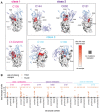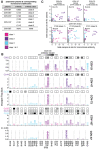This is a preprint.
Mutational escape from the polyclonal antibody response to SARS-CoV-2 infection is largely shaped by a single class of antibodies
- PMID: 33758856
- PMCID: PMC7987015
- DOI: 10.1101/2021.03.17.435863
Mutational escape from the polyclonal antibody response to SARS-CoV-2 infection is largely shaped by a single class of antibodies
Update in
-
Mapping mutations to the SARS-CoV-2 RBD that escape binding by different classes of antibodies.Nat Commun. 2021 Jul 7;12(1):4196. doi: 10.1038/s41467-021-24435-8. Nat Commun. 2021. PMID: 34234131 Free PMC article.
Abstract
Monoclonal antibodies targeting a variety of epitopes have been isolated from individuals previously infected with SARS-CoV-2, but the relative contributions of these different antibody classes to the polyclonal response remains unclear. Here we use a yeast-display system to map all mutations to the viral spike receptor-binding domain (RBD) that escape binding by representatives of three potently neutralizing classes of anti-RBD antibodies with high-resolution structures. We compare the antibody-escape maps to similar maps for convalescent polyclonal plasma, including plasma from individuals from whom some of the antibodies were isolated. The plasma-escape maps most closely resemble those of a single class of antibodies that target an epitope on the RBD that includes site E484. Therefore, although the human immune system can produce antibodies that target diverse RBD epitopes, in practice the polyclonal response to infection is dominated by a single class of antibodies targeting an epitope that is already undergoing rapid evolution.
Conflict of interest statement
Declarations of Interests
The Rockefeller University has filed a provisional patent application related to SARS-CoV-2 monoclonal antibodies on which D.F.R. and M.C.N. are inventors. The Rockefeller University has applied for a patent relating to the replication-competent VSV/SARS-CoV-2 chimeric virus on which Y.W, F.S., T.H., and P.B. are inventors (US patent 63/036,124). The other authors declare no competing interests.
Figures






References
-
- Faria N. R., Claro I. M., Candido D., Moyses Franco L. A., Andrade P. S., Coletti T. M., Silva C. A. M., Sales F. C., Manuli E. R., Aguiar R. S., Gaburo N., da C. Camilo C., Fraiji N. A., Esashika Crispim M. A., do Perpétuo S. S. Carvalho M., Rambaut A., Loman N., Pybus O. G., Sabino E. C. & on behalf of CADDE Genomic Network. Genomic characterisation of an emergent SARS-CoV-2 lineage in Manaus: preliminary findings. Virological (2021). at <https://virological.org/t/genomic-characterisation-of-an-emergent-sars-c...>
-
- Voloch C. M., Francisco R. Junior da S., de Almeida L. G. P., Cardoso C. C., Brustolini O. J., Gerber A. L., Guimaraes A. P. de C., Mariani D., da Costa R. M., Ferreira O. C. Junior, Cavalcanti A. C., Frauches T. S., de Mello C. M. B., Galiez R. de M., Faffe D. S., Castineira T. M. P. P., Tanuri A., de Vasconcelos A. T. R., Workgroup, C.-U. & LNCC-Workgroup. Genomic characterization of a novel SARS-CoV-2 lineage from Rio de Janeiro, Brazil. medRxiv (2020). doi:10.1101/2020.12.23.20248598 - DOI - PMC - PubMed
-
- West A. P., Barnes C. O., Yang Z. & Bjorkman P. J. SARS-CoV-2 lineage B.1.526 emerging in the New York region detected by software utility created to query the spike mutational landscape. bioRxiv 2021.02.14.431043 (2021). doi:10.1101/2021.02.14.431043 - DOI
-
- Annavajhala M. K., Mohri H., Zucker J. E., Sheng Z., Wang P., Gomez-Simmonds A., Ho D. D. & Uhlemann A.-C. A novel SARS-CoV-2 variant of concern, B.1.526, identified in New York. medRxiv (2021). doi:10.1101/2021.02.23.21252259 - DOI
Publication types
Grants and funding
LinkOut - more resources
Full Text Sources
Other Literature Sources
Miscellaneous
